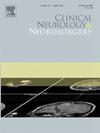Pre-operative collapsed disc is a negative prognostic factor of back-pain outcome in trans-foraminal endoscopic discectomy. A single cohort clinical study
IF 1.8
4区 医学
Q3 CLINICAL NEUROLOGY
引用次数: 0
Abstract
Purpose
Trans-foraminal endoscopic discectomy (TELD) is an alternative surgical technique for lumbar disc herniation (LDH). Compared with microscope-assisted open discectomy, TELD is expected to result in less postoperative low back pain (LBP) and has a lower likelihood of complications. However, some clinical analysis report patients still had persistent LBP at follow-up. Several studies have identified different known risk factors for LBP after TELD, including the preoperative presence of disc height loss and “microinstability” of the lumbar spine, which can be detrimental to a patient's successful outcome.
Methods
We conducted a retrospective review of a cohort of 86 patients with symptomatic LDH who underwent TELD surgery in a single Neurosurgery Unit from 2021 to 2023 and subjected themselves to a clinical and radiological follow-up program up to one year, focusing on the presence of collapsed disc (Group A) and the presence of normal intersomatic height (Group B) at the site of lumbar herniation.
Results
The two groups demonstrated no significant differences in the pain and disability scales at the preoperative and postoperative phases, both after surgery and during follow-up. However, at the 1-year clinical evaluation, patients who had signs of a collapsed disc before surgery experienced less recovery on the ODI scale compared to the other group
Conclusion
Our study showed that the presence of severe intervertebral disc height loss, accompanied by pre-operative signs of a collapsed disc at the site of the LDH, may serve as a predictor of poor postoperative pain recovery.
术前椎间盘塌陷是经腔镜椎间盘切除术后腰痛预后的一个负面因素。一项单一队列临床研究
目的经肛门内窥镜椎间盘切除术(TELD)是治疗腰椎间盘突出症(LDH)的另一种手术技术。与显微镜辅助下的开放式椎间盘切除术相比,经肛门内窥镜椎间盘切除术可减少术后腰痛,并降低并发症的发生率。然而,一些临床分析报告称,患者在随访时仍有持续的腰背痛。有几项研究发现了导致 TELD 术后 LBP 的不同已知风险因素,包括术前存在椎间盘高度缺失和腰椎 "微不稳定",这些因素都可能对患者的成功治疗不利。方法我们对 2021 年至 2023 年期间在一家神经外科单位接受 TELD 手术的 86 例无症状 LDH 患者进行了回顾性研究,并对他们进行了长达一年的临床和放射学随访,重点关注腰椎间盘是否塌陷(A 组)以及腰椎间盘突出部位是否有正常的椎间高度(B 组)。结论我们的研究表明,椎间盘高度严重减低并伴有腰椎间盘突出部位椎间盘塌陷的术前体征,可作为术后疼痛恢复不良的预测因素。
本文章由计算机程序翻译,如有差异,请以英文原文为准。
求助全文
约1分钟内获得全文
求助全文
来源期刊

Clinical Neurology and Neurosurgery
医学-临床神经学
CiteScore
3.70
自引率
5.30%
发文量
358
审稿时长
46 days
期刊介绍:
Clinical Neurology and Neurosurgery is devoted to publishing papers and reports on the clinical aspects of neurology and neurosurgery. It is an international forum for papers of high scientific standard that are of interest to Neurologists and Neurosurgeons world-wide.
 求助内容:
求助内容: 应助结果提醒方式:
应助结果提醒方式:


